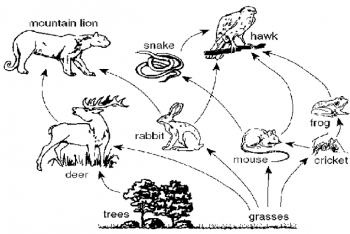Serendip is an independent site partnering with faculty at multiple colleges and universities around the world. Happy exploring!
Food Webs, Energy Flow, Carbon Cycles, and Trophic Pyramids

To begin this hands-on, minds-on activity, students view a video about changes in the ecosystem that resulted when wolves were eliminated from Yellowstone National Park and decades later returned to Yellowstone. Students learn about food chains and food webs, and they construct and analyze a food web for Yellowstone. Then, students use what they have learned to understand a trophic cascade caused by the elimination of wolves from Yellowstone.
Next, students learn that the biosphere requires a continuous inflow of energy, but does not need an inflow of carbon atoms. To understand why, students apply fundamental principles of physics to photosynthesis, cellular respiration, and biosynthesis, the processes which result in carbon cycles and energy flow through the biosphere.
Finally, students use the concepts they have learned to understand trophic pyramids and phenomena such as the relative population sizes for wolves vs. elk in Yellowstone. Thus, students learn how ecological phenomena result from processes at the molecular, cellular, and organismal levels.
For virtual instruction, you can use Food Webs – How did the elimination and return of wolves affect other populations in Yellowstone?, Carbon Cycles and Energy Flow through the Biosphere, and Trophic Pyramids.
This activity is aligned with the Next Generation Science Standards (NGSS).
Download Student Handout: PDF format or Word format
Download Teacher Preparation Notes: PDF format or Word format
Please note that Word files display differently on different computers, so you will want to use the PDF files to see the correct formatting of the Student Handout and the images for the cards for the food web in the Teacher Preparation Notes. The first file attached below is suitable for professional printing and cutting of the cards for the food web part of the activity. The second and third attached files provide an alternative, larger deck of cards, which you can use if you prefer for your students to construct a somewhat more complete food web.
We invite comments on this Hands-On Activity and the accompanying Teacher Preparation Notes. If you would prefer to send your comments or questions in a private message, please write Ingrid Waldron at iwaldron@sas.upenn.edu.
See also a complete list of activities: Minds-on Activities for Teaching Biology
| Attachment | Size |
|---|---|
| Yellowstone cards smaller deck (crrctd).pdf | 447.26 KB |
| Yellowstone cards larger deck.docx | 1.77 MB |
| Yellowstone cards larger deck (crrctd).pdf | 343.29 KB |











Comments
2025 revision
Some of the questions and diagrams have been clarified.
Ingrid
2024 revision
The Student Handout and Teacher Notes have been revised to take account of recent research findings. In addition, several questions and explanations have been clarified in the Student Handout. For example, the Student Handout now includes an introduction to trophic pyramids that clarifies the difference between gross and net rates of biomass production and motivates the use of net rates of biomass production for constructing trophic pyramids.
2021 revision
We have revised the Student Handout to improve clarity and the logical progression of student understanding.
Ingrid
Video
Video is no longer available
Video available
I am puzzled by your comment, since I found the video at https://www.learner.org/series/the-habitable-planet-a-systems-approach-to-environmental-science/ecosystems/ecosystems-video/. Please try again.
Thank you,
Ingrid
March 2019 revision
Based on helpful input from Philadelphia area teachers, the procedure in the Student Handout has been clarified to make it easier for students to construct an accurate food web. Some of the explanations and questions have been revised to improve student understanding.
Ingrid
2019 revision
The Student Handout has been reorganized and streamlined to teach the concepts more effectively. Each section begins with a phenomenon to stimulate student engagement and thinking. Many of the questions, figures and explanations have been revised for greater clarity.
biology
I just need to review the answer
Answer key
Please see the Teacher Preparation Notes for information about the answer key and other useful information.
Ingrid Waldron
2016 Revision
In this revision we have improved the accuracy of the descriptions of chemical energy and energy metabolism in the Student Handout and Teacher Preparation Notes. In addition, we have made available an alternative version of the deck of cards for the Yellowstone food web part of the activity for teachers who want a somewhat briefer, simpler food web activity.
Answer Key
Where can I find the answer key?
Answer key
Please see the Teacher Preparation Notes which include learning goals, instructional suggestions, and background biology, as well as instructions about how to get the key.
Post new comment